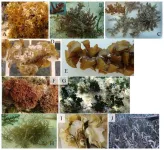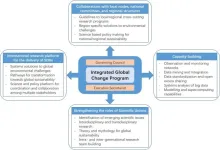(Press-News.org) Researchers from Indiana University and Texas Christian University published a new Journal of Marketing study that examines the impact of a hospital’s portfolio strategy on patient demand.
The study, forthcoming in the Journal of Marketing, is titled “Hospital Portfolio Strategy and Patient Choice” and is authored by Sarang Sunder and Sriram Thirumalai.
Structural changes in the healthcare industry (e.g., the institution of the Affordable Care Act) over the past decade, as well as advancements in technology and care delivery, have resulted in an unprecedented shift toward patient-centric care. This means that marketing is now a critical differentiating factor in the healthcare industry. While hospitals have tried a number of marketing strategies with varying degrees of success, one aspect largely ignored is a hospital’s organization of its service offerings, or its portfolio strategy.
This new study assesses the impact of a hospital’s portfolio strategy on patient demand. A growing trend in healthcare in recent years has centered on hospital portfolio strategy—hospitals making key portfolio decisions such as expanding or contracting emphasis on care delivery within select departments. For example, Sanford Health, one of the largest rural health systems in the U.S., expanded its emphasis on cancer care services with an allocation of a new dedicated center with specialists, facility, and technology. Orlando Health recently opened an entire hospital unit just for Orthopedic care. These portfolio decisions call for significant resource investments, often running into millions of dollars.
But do these portfolio decisions pay off? This is a common dilemma that hospital CEOs face. Should they invest toward specializing in an area? Or diversify across other areas? If so, which areas should they invest or divest in? Through a series of empirical analyses involving secondary data on inpatient discharges, coupled with experiments, the researchers shed light on these questions.
Effect of Portfolio Strategy on Demand
Sunder explains that “we define a hospital’s portfolio strategy across two dimensions. The first is focus, which is the depth of expertise within a category. The second dimension is related focus, which is the breadth of expertise across related categories.” Hospitals with a high focus on a department may be regarded as “specialists” with a high depth of expertise in that category (e.g., Shouldice Hospital for hernias). Hospitals with a high related focus in a department (e.g., cardiology) are selectively focused on multiple other categories (e.g., endocrinology, respiratory, and digestive systems) that are clinically relevant to that department (e.g., Cleveland Clinic).
A hospital’s portfolio strategy can shape patient preference in important ways. There is value to specialization or focus. An increase in a hospital’s focus in a department leads to a significant increase in market share. However, some patients prefer hospitals that are able to signal breadth of expertise (i.e., focusing in related areas has a positive effect on market share). The results strongly suggest that patients do pay attention to hospital portfolios.
While the effects are significant and substantive, it is also important to know why they are so. “We demonstrate that portfolio strategy can act as a strong signal of clinical quality, which patients care deeply about. Put differently, our results highlight the value of reputation/competence signaling by hospitals through their service portfolios, in particular for patients with complex needs,” says Thirumalai.
Lessons for Chief Marketing Officers
This study offers guidance to executives in healthcare, especially those in management roles at hospitals.
The revenue implications of portfolio strategy are sizeable. While the portfolio effects are indeed positive on average, the effect varies a lot across hospital departments. In other words, where you focus matters! For instance, while a 1% increase in focus on the kidney and urinary tract department translates to a 0.9% increase in market share (about $181,000 in annual revenue), a corresponding increase in focus on the ear, nose, and throat department is associated with a 0.8% increase in market share (about $84,835 in annual revenue). Thus, there may be larger benefits from focusing on some departments than others, rendering it suboptimal to follow a one-size-fits-all approach to portfolio growth.
Organize your portfolio based on its effects on demand. For some departments (e.g., kidney and urinary tract), patient preference for both focus and related focus is high. These departments stand to gain the most by building depth of expertise in the focal category and breadth in related areas of care. In contrast, for departments such as cardiology and endocrinology, the benefits are higher for pursuing only one of the portfolio strategies, which thus calls for a nuanced approach to portfolio strategy across departments.
Potential for targeted positioning. The research indicates that patients’ preference for focus and related focus is higher when their care needs are more complex. The study’s results show that patients may find greater value in focus and related focus capabilities when faced with complex needs, indicative of an upside market potential of focus that perhaps remains untapped. In other words, while portfolio decisions have largely been a supply-side decision, the study points to the demand-side potential by highlighting its relevance among the complex patient population.
In summary, the research indicates that hospitals have the opportunity to leverage portfolio strategy to target specific patient populations, further enhancing their patient-centric capabilities.
Full article and author contact information available at: https://doi.org/10.1177/00222429231204247
About the Journal of Marketing
The Journal of Marketing develops and disseminates knowledge about real-world marketing questions useful to scholars, educators, managers, policy makers, consumers, and other societal stakeholders around the world. Published by the American Marketing Association since its founding in 1936, JM has played a significant role in shaping the content and boundaries of the marketing discipline. Shrihari (Hari) Sridhar (Joe Foster ’56 Chair in Business Leadership, Professor of Marketing at Mays Business School, Texas A&M University) serves as the current Editor in Chief.
https://www.ama.org/jm
About the American Marketing Association (AMA)
As the largest chapter-based marketing association in the world, the AMA is trusted by marketing and sales professionals to help them discover what is coming next in the industry. The AMA has a community of local chapters in more than 70 cities and 350 college campuses throughout North America. The AMA is home to award-winning content, PCM® professional certification, premiere academic journals, and industry-leading training events and conferences.
https://www.ama.org
END
Should a hospital invest toward specializing in an area? Or diversify? The impact of a hospital’s portfolio strategy on patient demand
News from the Journal of Marketing
2023-11-15
ELSE PRESS RELEASES FROM THIS DATE:
Surveilling wetlands for infectious bird flu — and finding it
2023-11-15
Recently, morning omelets and holiday dinners have gotten more expensive. One likely cause is bird flu, outbreaks of which led to the deaths of millions of chickens and turkeys from infection or culling in 2022, according to the U.S. Department of Agriculture, and which still demands rigorous monitoring of wild populations. Now, reporting in Environmental Science & Technology Letters, researchers have developed a method that detected infectious bird flu virus in wetlands frequented by waterfowl.
Wild birds represent a significant reservoir of avian influenza ...
Not so silver lining: Microplastics found in clouds could affect the weather
2023-11-15
From the depths of the seas to snow on mountains and even the air above cities, microplastics are turning up increasingly often. Now, in ACS’ Environmental Science & Technology Letters, researchers have analyzed microplastics in clouds above mountains. They suggest that these tiny particles could play a role in cloud formation and, in turn, affect weather.
Microplastics — plastic fragments smaller than five millimeters — originate from a myriad of items used daily, such as clothing, packaging and car tires. As research in the field evolves, scientists are not only detecting microplastics in the atmosphere but also investigating how they may play a role in cloud formation. ...
Association of molecular subtypes in bladder cancer with response to neoadjuvant chemotherapy, progression, and survival
2023-11-15
Considering the molecular subtype of muscle-invasive bladder cancer (MIBC) based on differences in tumor RNA expression can improve the ability of an existing tumor biomarker such as the COXEN score to predict which patients’ tumors are likely to respond to chemotherapy given before surgery. Individual molecular subtypes, however, were not associated with significant differences in patients’ overall survival (OS) or progression-free survival (PFS) times.
Those are the conclusions from a secondary analysis of data from the S1314 clinical trial, a large study in patients with MIBC that was conducted by the SWOG Cancer Research Network, a clinical trials group funded by ...
Colliding ribosomes activate RNA repair
2023-11-15
Aldehydes are toxic compounds that are produced in the body by metabolic processes, especially upon alcohol consumption. They are dangerous because they bind to cellular macromolecules such as DNA, RNA, and proteins, and crosslink them.
Crosslinking damage to DNA must be repaired by the cell to prevent premature aging and cancer. However, it was previously unknown whether and how cells sense and resolve crosslinking damage to single-stranded RNA. A team led by Professor Julian Stingele from ...
On two small islands in the Indian Ocean, an endangered palm with the world’s largest seed sows a lesson about landscape restoration
2023-11-15
Every tree species has its story. Unraveling all 73,000 of them is a significant undertaking for science, in no small part because a considerable proportion of tree biodiversity is tropical, rare, remote and subject to the ravages of deforestation. And an estimated 9,200 tree species have yet to be discovered.
Even trees well-known to science have mysteries. One is the Seychelles’ endangered coco de mer, or sea coconut palm tree, which is now relegated to parts of two small Indian Ocean islands and in decline. Only some 8,200 individuals remain.
What Lodoicea madivica lacks in range it makes ...
New scientific study reveals the crucial role of herbivorous fishes and sea urchins in restoring Caribbean coral reefs
2023-11-15
A new study by Dr. Lindsay Spiers (Florida Fish and Wildlife Conservation Commission) and Professor Thomas Frazer (College of Marine Science at the University of South Florida), published in PeerJ Life & Environment, presents crucial findings on the feeding preferences of herbivorous fishes and the sea urchin Diadema antillarum in Little Cayman. The study, titled "Comparison of feeding preferences of herbivorous fishes and the sea urchin Diadema antillarum in Little Cayman," sheds new light on the dynamics of these herbivores and their impact on the resilience of Caribbean coral reefs.
Caribbean coral reefs face significant challenges, ...
The Future of Future Earth: How global science programs can navigate the complex, shifting challenges in sustainability science
2023-11-15
The global change program Future Earth is an international alliance of organizations and agencies that was launched by the UN in June 2012. The Future Earth 2025 Vision identified eight global challenges for scientific research to accelerate progress in sustainability, improve collaboration, and mobilize resources.
After more than a decade of this global change program, researchers are analyzing the challenges Future Earth has faced and the path forward. Discussion presented in a recently published paper reviews these challenges faced by the coalition and proposes solutions to help these programs meet the many needs of the global community.
The paper was published on ...
Georgetown Global Health Center launches first open-access wildlife disease database
2023-11-15
WASHINGTON (November 15, 2023) – Georgetown University Medical Center’s Center for Global Health Science and Security (GHSS) today announces the launch of a first-of-its-kind wildlife disease database -- a system for collecting records of viruses, bacteria, fungi, parasites, etc. -- designed to support an early warning system for potential viral emergence. The Pathogen Harmonized Observatory, or PHAROS, is open to the global community and free to access.
Scientists in GHSS’ Verena program, a collaborative ...
University of Basel delivers first biological implants for treatment of cartilage lesions and osteoarthritis in humans
2023-11-15
The Department of Biomedicine at the University of Basel and the University Hospital Basel, today announced that it delivered the first surgical procedure to treat Osteoarthritis (OA) in humans. The procedure called Nasal Chondrocyte Tissue-Engineered Cartilage, or N-TEC, provides an innovative alternative to cure confined knee cartilage lesions as well as to address degenerative OA cases that have to date required knee joint replacements – prosthetics that routinely need replacing after 15-20 years.
The team at Basel is spearheading the next-generation human clinical trials that will ...
From 2018 to 2022, eating disorder claim lines increased 65 percent nationally as a percentage of all medical claim lines
2023-11-15
NEW YORK, NY—November 15, 2023—From 2018 to 2022, eating disorder claim lines increased 65 percent nationally as a percentage of all medical claim lines.[1] All eating disorders studied increased during this period, but at different rates: avoidant/restrictive food intake disorder (ARFID) by 305 percent,[2] binge-eating disorder by 81 percent, anorexia nervosa (anorexia) by 73 percent and bulimia nervosa (bulimia) by 3 percent. These and other findings on eating disorders are reported in a FAIR Health white paper released today: Spotlight on Eating Disorders: An Analysis of Private Healthcare Claims.
Eating ...
LAST 30 PRESS RELEASES:
Making lighter work of calculating fluid and heat flow
Normalizing blood sugar can halve heart attack risk
Lowering blood sugar cuts heart attack risk in people with prediabetes
Study links genetic variants to risk of blinding eye disease in premature infants
Non-opioid ‘pain sponge’ therapy halts cartilage degeneration and relieves chronic pain
AI can pick up cultural values by mimicking how kids learn
China’s ecological redlines offer fast track to 30 x 30 global conservation goal
Invisible indoor threats: emerging household contaminants and their growing risks to human health
Adding antibody treatment to chemo boosts outcomes for children with rare cancer
Germline pathogenic variants among women without a history of breast cancer
Tanning beds triple melanoma risk, potentially causing broad DNA damage
Unique bond identified as key to viral infection speed
Indoor tanning makes youthful skin much older on a genetic level
Mouse model sheds new light on the causes and potential solutions to human GI problems linked to muscular dystrophy
The Journal of Nuclear Medicine ahead-of-print tip sheet: December 12, 2025
Smarter tools for peering into the microscopic world
Applications open for funding to conduct research in the Kinsey Institute archives
Global measure underestimates the severity of food insecurity
Child survivors of critical illness are missing out on timely follow up care
Risk-based vs annual breast cancer screening / the WISDOM randomized clinical trial
University of Toronto launches Electric Vehicle Innovation Ontario to accelerate advanced EV technologies and build Canada’s innovation advantage
Early relapse predicts poor outcomes in aggressive blood cancer
American College of Lifestyle Medicine applauds two CMS models aligned with lifestyle medicine practice and reimbursement
Clinical trial finds cannabis use not a barrier to quitting nicotine vaping
Supplemental nutrition assistance program policies and food insecurity
Switching immune cells to “night mode” could limit damage after a heart attack, study suggests
URI-based Global RIghts Project report spotlights continued troubling trends in worldwide inhumane treatment
Neutrophils are less aggressive at night, explaining why nighttime heart attacks cause less damage than daytime events
Menopausal hormone therapy may not pose breast cancer risk for women with BRCA mutations
Mobile health tool may improve quality of life for adolescent and young adult breast cancer survivors
[Press-News.org] Should a hospital invest toward specializing in an area? Or diversify? The impact of a hospital’s portfolio strategy on patient demandNews from the Journal of Marketing





